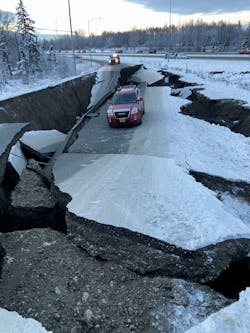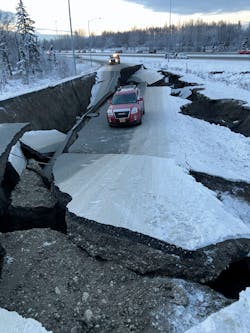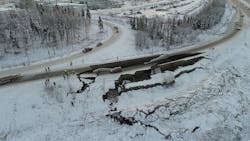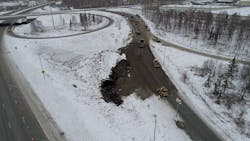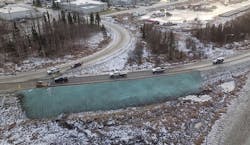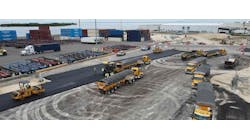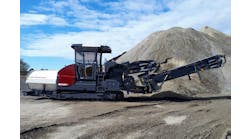By: Caitlin Frye
At 8:29 a.m. on Friday, Nov. 30, 2018, the earth started rocking and shaking in Anchorage, Alaska.
At the Alaska Department of Transportation and Public Facilities (DOT&PF) headquarters, ceiling tiles fell on desks, shelves and their contents spilled onto the floor, and families anxiously texted to make sure everyone was all right. The moment the 7.0-magnitude earthquake stopped, amid the rubble and chaos, DOT&PF staff got to work. Bob Anderson, maintenance chief for DOT&PF’s Central Region, summed up the attitude shared by many of his colleagues and the Alaska contracting community: “We knew if we didn’t jump on this and get it fixed, it wouldn’t get done.”
Within minutes, photos of roads broken into pieces like fractured glass started popping up on smart phones. By 9 a.m., an Emergency Operations Center had been established in the regional headquarters’ main conference room, and supplies and employees were arriving and organizing. Right away, DOT&PF staff began creating inventories of the work to be done, and contractors were calling in with offers to help.
Staff identified eight sites as the highest priority for immediate repair (out of nearly 60 sites that would eventually need significant repairs due to the earthquake). One of the most dramatic of those sites was located at the Minnesota Drive and International Airport Road interchange in Anchorage. Photos of an SUV stranded in the middle of a collapsed road were some of the first images to be released after the earthquake and would prove to be among the most iconic of this disaster.
In fact, this intersection was one of the first damage sites seen by DOT&PF Project Engineer Mahear Abou Eid after the quake. He had been working out of a project office near the airport when the ground started shaking. After the quake subsided, and phone calls to his family in a remote coastal village proved everyone was all right, Abou Eid started driving home. As he drove past the Minnesota and International interchange, only minutes away from his project office, he saw the collapsed road and wondered how widespread the damage was.
This stranded SUV at the Minnesota Drive and International Airport Road interchange became a national focal point for the pervasiveness of the earthquake damage, and also served as a visual signal to Alaskan authorities and local contractors, who pooled their resources to find a swift solution to the damage.
Ready to work
By 9:30 a.m., only an hour after the earthquake, Abou Eid was at headquarters with an assignment to oversee repairs at the northbound Minnesota off-ramp to International Airport Road. Contractor Knik Construction already was on board as the general contractor. An hour after that, just two hours after the quake, Abou Eid was on-site with the superintendent from Knik Construction. Before noon, the stranded SUV had been towed, equipment was mobilized on-site, subcontractors were discussing the repair plan, and word came in from the paving subcontractor that the paving plant was already heating up.
Late November is a particularly inconvenient time for an earthquake to rip up roads in Alaska—or more specifically, it is an inconvenient time to have to repair them as a result of it. As Dave Kemp, DOT&PF’s central region director, said in a press conference two days following the quake, “We’re going to be paving at the worst possible time of year ... This is probably the most challenging paving we’ve ever done.”
Alaska’s construction season is short and intense. In the Anchorage area, it typically begins in May and wraps up in October. After that point, the weather is too dicey to guarantee quality paving will be possible. In fact, any paving that is performed after Oct. 15 in any given year has to be specifically approved by the DOT&PF regional construction engineer.
Contractors typically winterize their asphalt plants around mid-October, which basically entails turning off all the equipment and letting it freeze solid until winter is over. Consequently, the oil used in the production of asphalt was frozen in large tanks and had to be thawed and reheated over a period of several days to get it back into good working shape. And crews were not able to just flip a switch the minute after the earthquake ended to get that process started—all the equipment had to be checked for damage before being turned on.
The equipment is not the only thing at an asphalt plant that gets winterized—staff do their own kind of winterizing. After working through the intense construction season, November and December are prime months for a few weeks vacation to a tropical destination. One challenge was getting employees back into the office—and back into the state—to get the work done.
Under typical circumstances, by the time the contractor and project engineer are talking about paving at a construction site, a whole suite of preparation activities have already taken place: utilities located, buried culverts identified, as-built plans reviewed, design sets stamped, traffic-control plans approved. But these were not typical circumstances—it all had to get done on the fly.
The Alaska DOT&PF had boots on the ground within hours of the earthquake, making assessments and reaching out to local contractors in order to fast-track repair work.
Determined to succeed
On-the-fly construction was one of the biggest challenges faced by the team, but it also was one of its greatest successes. As Abou Eid described it, “Contractors came alive.” The determined energy on the part of all the players was impressive. Contractors, subcontractors, utility companies, and maintenance crews all jumped at every request, responded immediately, and made sure their part was done quickly and thoroughly.
A representative from the natural gas utility was on-site within four hours of the quake to confirm that no gas leaks were present. When a surprise damaged culvert was discovered and the contractor did not have a replacement on hand, a DOT&PF staff member tracked one down and it was on-site within 90 minutes. By the time Abou Eid had his phone out to call state maintenance crews to spread some sand on the icy roads, he saw a municipal sanding truck roll in—the contractor had called in a favor. Four hours after a landscaping company had been contacted to assist with slope stabilization, their trucks were spraying bonded fiber matrix on the slope.
But determination was not the only thing that brought this project to success. Two other important factors were skill and luck. The latter may have been out of the crew’s control, but worked in their favor. Although temperatures were much colder than would normally be acceptable for paving, it was not as cold as it could have been. Average temperatures for that time of year are between 15 and 30°F, but it stayed at the high end—just below 30°F—as paving began. And although a big snow was forecast to hit that day, the first flake did not fall until after paving was complete.
Skill, even more than luck, was present from the get-go. The experienced construction team had to overcome both time and temperature challenges to achieve sufficient compaction with the asphalt. Although they knew these repairs would be temporary—more robust and long-term repairs will be needed this summer when conditions are ideal—the wintertime repairs would still have to last for up to eight months. After all, winter in Alaska is long.
Racing against the snow-filled forecast, the asphalt plant, run by contractor Quality Asphalt Paving (QAP), had been warming up since only hours after the quake. It takes a long time for a big tank of oil to get hot, but QAP said it would be ready by 8 p.m. on Monday night. The night before, wind and rain had shut down overnight hauling operations for fill materials, and with more snow in the forecast, paving couldn’t begin quickly enough. After a few hours of prep time, the first asphalt truck placed its first load on the ground only 15 minutes after 8 p.m.
Temperatures, which can average as low as 15°F for that time of year, held out closer to 30°F as paving began, giving crews a bit of much-needed luck. The asphalt plant was only four minutes’ drive from the site, so little to no material heat was lost in the transfer.
The right stuff
Asphalt is usually heated to about 300-320°F, but QAP got this asphalt up to 340°F to combat the freezing temperatures outside. The drive from the plant to the site took the trucks about four minutes, so they were not hampered by a long haul. Nonetheless, the crew waited until two asphalt trucks had arrived before they started paving. They wanted to ensure there was a continuous paving process with as little downtime as possible. Trucks only unloaded when the paver was ready to go. The temperature of the asphalt was measured more frequently than normal, but it stayed where it needed to be. It took two passes to pave the site—it was only about 220 ft long. The asphalt mat was 3 in. thick—1 in. thicker than usual to keep temperatures up—and by the time the rollers had completed four passes, temperatures were still holding at about 250°F.
At 11 p.m. on Monday, Dec. 3, less than 87 hours after the earthquake, striping was completed on the cooled and compacted asphalt, and the ramp was ready for traffic.
This is the story of only one site out of eight major work sites and nearly 60 sites total that needed repairs. Everyone on this project was simultaneously helping on other projects in the area. The Minnesota and International ramps were some of the first sites to be completed, but the other major sites followed in short order.
All the players in making these repairs happen had the same attitude from the start: Get it done. None of this would have been possible without grit, determination, lots of skill and a little bit of luck. As Bob Anderson put it a few weeks after the earthquake, “You always hear that Alaskans are tough, but now we’ve seen it.”
Slope was stabilized with a spray-on bonded fiber matrix, and crews paved the asphalt mat 1 in. thicker than normal, in order to keep temperatures up. Even after compaction, the mat stood at 250°F.
About The Author: Frye is Northern Region Information Officer for the Alaska Department of Transportation & Public Facilities.
